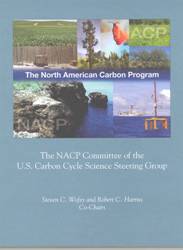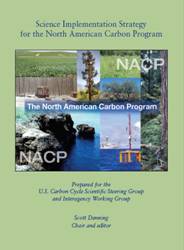North American Carbon Program (NACP)
Overview
Main Goals
Science Plan
Implementation Strategy

Overview
The North American Carbon Program (NACP) is a multi-agency, multidisciplinary scientific research program focused on carbon sources and sinks in North America and its adjacent oceans. NACP’s success relies on coordination among observational, experimental, and modeling efforts regarding terrestrial, oceanic, atmospheric, and human components of the carbon cycle. NACP relies upon a rich and diverse array of existing observational networks, monitoring sites, and experimental field studies. NACP is a primary activity of the US Carbon Cycle Science Program in conjunction with the US Ocean Carbon & Biogeochemistry Program. While many NACP projects are supported by US federal agencies through intra- and extramural funding mechanisms, membership is not limited to US-funded participants and projects.
With a focus on sources and sinks of carbon for North America and its coastal waters, the North American Carbon Program emphasizes diagnosis of the contemporary carbon cycle, scientific understanding of how it responds to natural and human forcings, and skillful predictions of its likely future dynamics. The program also aims to provide scientific assessments of a range of policy and management options being considered to mitigate climate change and ocean acidification by protecting and expanding land, aquatic, or oceanic carbon stocks. As such, the NACP plays a vital role in global carbon cycle research and its applications in service to society.
Main Goals
As outlined in the 2022 NACP Science Implementation Plan, NACP's main goals are to:
- Develop quantitative scientific knowledge, robust observations, and models to determine the emissions and uptake of CO2, CH4, and CO, changes in carbon stocks, and the factors regulating these processes for North America and adjacent ocean basins.
- Develop the scientific basis to implement full carbon accounting on regional and continental scales. This is the knowledge base needed to design monitoring programs for natural and managed CO2 sinks and emissions of CH4.
- Support long-term quantitative measurements of fluxes, sources, and sinks of atmospheric CO2 and CH4, and develop forecasts for future trends.
NACP has a Science Leadership Group (SLG) responsible for strategic planning. This leadership is made up of volunteers from the research community, including members of academia, research networks, federal research centers, NGOs, and the private sector. NACP’s SLG works closely with the Carbon Cycle Interagency Working Group (CCIWG) and OCB’s Carbon and Biogeochemistry Science Steering Group (SSG). The SLG exhibits a breadth of knowledge and expertise in modeling, observation (remote sensing and in situ), experimentation, and integration.
Science Plan

The report on the North American Carbon Program (Wofsy and Harriss, 2002) provides the scientific rationale for a coordinated surface and space observational program, land and ocean observation and experimental study, numerical modeling, and data assimilation effort for the terrestrial, coastal ocean and atmospheric components of the carbon cycle over North America and adjacent ocean basins. The report was prepared at the request of the Carbon Cycle Scientific Steering Group (CCSSG) and the Carbon Cycle Interagency Working Group (CCIWG). The report outlines a strategy to implement a principal recommendation of the U.S. Carbon Cycle Science Plan (Sarmiento and Wofsy, 1999). The central objective is to measure and understand the major reservoirs, sources, and sinks for carbon dioxide, methane, and carbon monoxide in North America. The goals are to develop quantitative scientific knowledge, robust observations, and advanced numerical models to determine the emissions and sinks of these gases, changes in carbon reservoirs, and the factors regulating these processes, and to develop the scientific foundation to implement full carbon accounting on regional and continental scales. This is the knowledge base needed to design effective monitoring programs for natural and managed carbon dioxide sinks and emissions of carbon dioxide, methane, and carbon monoxide; to support long-term quantitative measurements of fluxes, sources, and sinks of atmospheric carbon dioxide, methane, and carbon monoxide; and to develop better forecasting capability for future trends. The program is also designed to advance science for other critical problems on the large-scale emissions, transformations, and long-range transport of pollutants; changes in species composition, health and productivity; the vulnerability to fire and drought of forests, croplands, and wild land; and forecasts of weather and climate.
Implementation Strategy

The Science Implementation Strategy for the North American Carbon Program (Denning et al., 2005) builds on the NACP report (Wofsy and Harriss, 2002). The implementation strategy is organized around four major themes: diagnosis, attribution/process, prediction, and decision support. The results will contribute to an integrated and well-tested system for understanding, monitoring, and predicting carbon fluxes over North America and the adjacent coastal ocean, and for providing timely and useful information to scientists, agencies, policymakers and other stakeholders in the carbon cycle and climate change.
A new Science Implementation Plan was published in 2022, highlighting key gaps and offering strategies for program implementation. It built on the 2005 NACP Science Implementation Plan, focusing on the highest priorities as calculated by determining the largest uncertainties, the weakest understanding, and the greatest public need.




